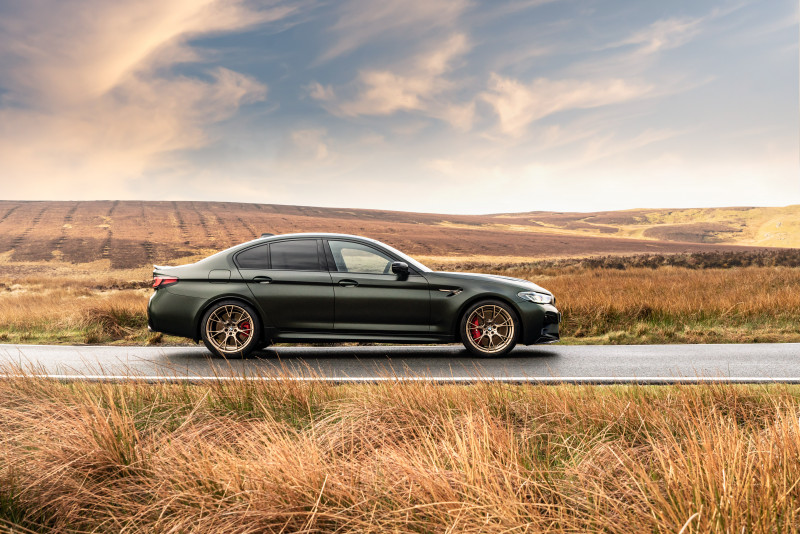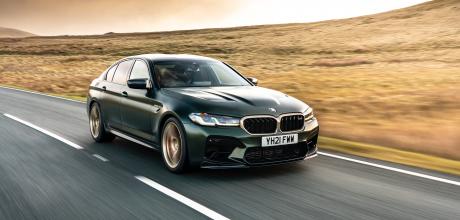2022 BMW M5 CS F90
Like the F90 M5 Competition? You’re going to love the new CS – BMW’s complete supersaloon… Words: Shane O’ Donoghue Photographs: BMW
The planning meeting must have been a riot. I picture the project leader at the top of the room with a whiteboard and markers asking his team to throw ideas at him. “Nürburgring stitching on the seats,” shouted one of the younger lads from the back. “Ve must ‘ave more power,” said the serious looking engineer sitting up front, “and tyres that can cope with our suspension changes,” he added after the initial embarrassment of speaking up in public. All this is being furiously conveyed to the whiteboard in multi-coloured markers. “Aero” is underlined, “weight reduction” is written in caps and then a quiet voice from the corner pipes up: “yellow lights.” The room goes quiet. Then erupts in thunderous applause. The concept for the ultimate incarnation of the F90, the M5 CS, is born.

Fast forward to our chance to drive the car for the first time. And it’s difficult not to be seduced by the combination of the ‘Frozen Deep Green metallic’ paintwork, ‘Goldbronze’ accents and yes, those sublime yellow lights. BMW’s Laserlight technology is standard on the M5 CS, with darkened surrounds, while the regular daytime running lights are white. However, if you switch on dipped or main beams, the L-shaped LED tubes turn yellow, giving this 5 Series an incredibly distinctive light signature. It’s a nod to BMW’s GT racers, which feature yellow lights so that drivers can tell which class the car behind is in – as introduced for Le Mans.
The racer-for-the-road theme goes further than that for the M5 CS, though it’s not an overtly obvious exterior makeover. Saying that, there is a new bonnet with extra vents made from Carbon Fibre Reinforced Plastic (CFRP), while carbon fibre is also used for the more jutting splitter up front, the aerodynamic diffuser at the back, a new boot spoiler and the same door mirror caps as fitted to the BMW M8 Competition. Pop open the bonnet and you’ll discover a large ‘M5 CS’ logo within the weave on the underside, while the engine is covered with a stylised carbon fibre panel and the intake silencer is exposed carbon fibre, too.
Meanwhile, it’s impossible to miss the Goldbronze 20-inch wheels, and the same colour is applied to the kidney grille surround, the M gills on the front wings and the model badging. As standard, those rims wear Pirelli P Zero Corsa track tyres, measuring 275/35 R20 at the front and 285/35 R20 at the rear. A glance within those wheels in our test car revealed red brake callipers, which might lead some to suspect that M Carbon ceramic brakes are not fitted, but actually, they’re standard, and the buyer can choose red or gold paint for the callipers. Red is the right choice.
Incidentally, the brakes, bonnet, carbon fibre parts and other measures result in a useful 70kg weight reduction in comparison to the M5 Competition. It sounds like a small number against the 1900kg kerb weight, but it’s still a significant amount of mass for the engine and chassis to not have to deal with. Especially as some 23kg of that comes from the brakes, counted as ‘upsprung’ mass.
More weight reduction is found inside the M5 CS, where it follows the lead of other CS models with the removal of the regular underarm cubby. A bespoke dashboard finish features the CS logo, which is repeated in the space between the rear seats. This model is a strict four-seater, and even the rear seats look and feel seriously supportive. The front two chairs are M Carbon seats, with big holes where padding isn’t needed, presumably to allow the fitment of racing harnesses. Even so, full electric adjustment and heating is included. Thanks to electric adjustment of their width, they’re exceedingly comfortable over a long duration at the wheel, though we never did get used to the odd carbon fibre lump in the seat between your legs.
The M5 CS gets a tactile M Alcantara steering wheel with a red-stitched 12 o’clock marker and gorgeous carbon fibre gearchange paddles behind, along with the two red M mode buttons to quickly activate your favourite group of driving settings that are found on all current BMW M cars. In the centre console, the M Steptronic transmission shifter is chunky, with its Drivelogic switch on top, the rotary iDrive controller is to one side, while an M-specific set of buttons allow access to the various driving sub-systems, key to customising the M5 to your liking.
Press the button marked ‘SETUP’ and a clear menu pops up on the centrally-mounted touchscreen to choose your preferences for the damping, power steering, all-wheel-drive system and engine map. This is where you set up the M1 and M2 buttons, as well.
The chassis of the M5 CS is based on that of the Competition model, but with tweaks to the spring and damper settings to allow for the lower weight and stickier tyres. There’s a seven-millimetre drop in ride height to lower the centre of gravity and the adaptive dampers from the M8 Gran Coupé have been fitted. BMW claims that these allow a wider range of abilities, including greater comfort at one end of the spectrum and better body control at the other. As our time at the wheel of the M5 CS was restricted to the track, we can only confirm that the big saloon feels better tied down than ever, even in the Comfort or Sport damper settings. The Sport+ mode is so firm that you’ll need a particularly smooth circuit to make the most of it.
A special mention should be given to the steering of the CS. We prefer it left in the Comfort mode for assistance, as the Sport modes offer too much resistance and actually disguises the otherwise clear stream of communication between your hands and the front tyres. It’s quite ludicrous how much frontend grip this car generates, and how detailed the feedback is. Turn-in is lightning-quick, yet somehow without any nervousness, and there’s no waiting a split second for the car’s weight to settle on the outside springs, either; it’s sublime.
This composure and responsiveness give you the confidence to lean on the chassis and that’s when you’ll discover how balanced the whole car is. Hard braking into a slow corner with a little steering lock on? No problem. Need to trim your line on a long sweeping bend that tightens at the exit? A minute flex of your right ankle does the trick. And, while the M5 CS is supremely capable, it also manages to engage the driver fully in the experience rather than make it feel like the car is doing all the graft.
Of course, like all versions of the current M5, the way the CS goes through a bend depends on which of the M xDrive settings you’ve chosen. By default, the car is in 4WD mode. This has been designed to make it feel like a rear-drive car to a certain extent, but it’s a very safe setup. If you push on, the chassis feels more neutral than rear-drive. It’s a good default setting and ideal for wet or icy road use.
To access the other options, you must first disable the Dynamic Stability Control (DSC). Then you can choose our favourite mode, 4WD Sport. This sends much more of the engine’s power to the rear wheels more of the time and it feels like a rear-drive car with an incredible amount of traction. It will make most drivers feel like a hero on track, as it offers huge adjustability at the limit, plus a little helping hand to pull the car out of corners from the front when needs be. It’s possible to drift the car in this setting if you have the skill, space and tyre budget. But if that’s your cup of tea, there’s always the 2WD setting to play with, sending all power to the rear wheels without any electronic driver assistance to help you out. The car isn’t as unstable in this mode as you might expect, but in truth, it doesn’t make it any more involving than the 4WD Sport setting, unless you want to smoke the tyres at every corner of course.
As ever, the twin-turbocharged 4.4-litre V8 is a willing and able accomplice to such hooliganism. BMW M has upped peak power by 10hp to 635hp, while maximum torque of 553lb ft is produced all the way from 1800rpm to 5950rpm. That tiny increase in power works with the weight reduction to drop the 0-62mph time to three seconds dead, which is quite something in a vehicle that is, in effect, a large luxury saloon. It’s a monster of an engine, roaring through the restyled stainless steel quad exhaust system from idle to redline with significant acceleration on tap seemingly at any speed. The eight-speed automatic gearbox is well up to the job of dealing with its output, too, though some people might hanker after a more engaging transmission.
There you have it. The M5 Competition was already a brilliant, exciting sports saloon. Now, is the CS worth the near-£40,000 premium?
Perhaps not by any logical measure, but buyers in this stratosphere are unlikely to have value at the top of their list of priorities. If you’re in the market for a new M5 now, then surely the CS is the only option to consider? And those in such an enviable position will be mighty glad that every idea raised in that initial planning meeting made it through to production. This will go down in history as one of the great M5s. Let’s hope its owners get as excited about it as we assume the people that created it did.
This will go down in history as one of the great M5s...
2022 BMW M5 CS F90
- ENGINE: twin-turbocharged V8 petrol, longitudinally mounted
- CAPACITY: 4395cc
- MAX POWER: 635bhp at 6000rpm
- MAX TORQUE: 553lb ft at 1800-5950rpm
- 0-62MPH: 3.0-seconds
- TOP SPEED: 189mph
- ECONOMY: 5.0mpg
- EMISSIONS (CO²): 57g/km
- WEIGHT (EU): 1900kg
- PRICE (OTR): £140,780


